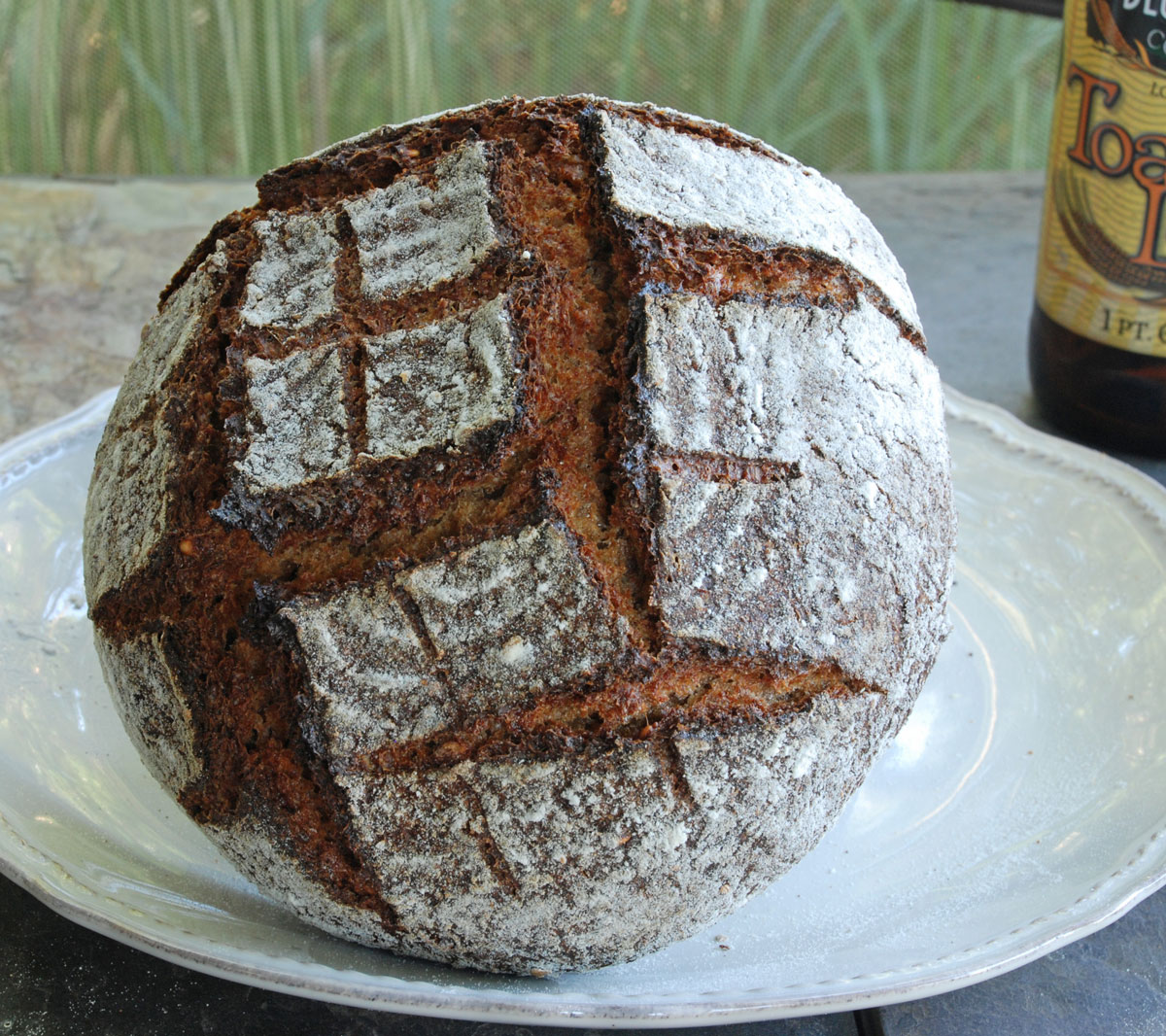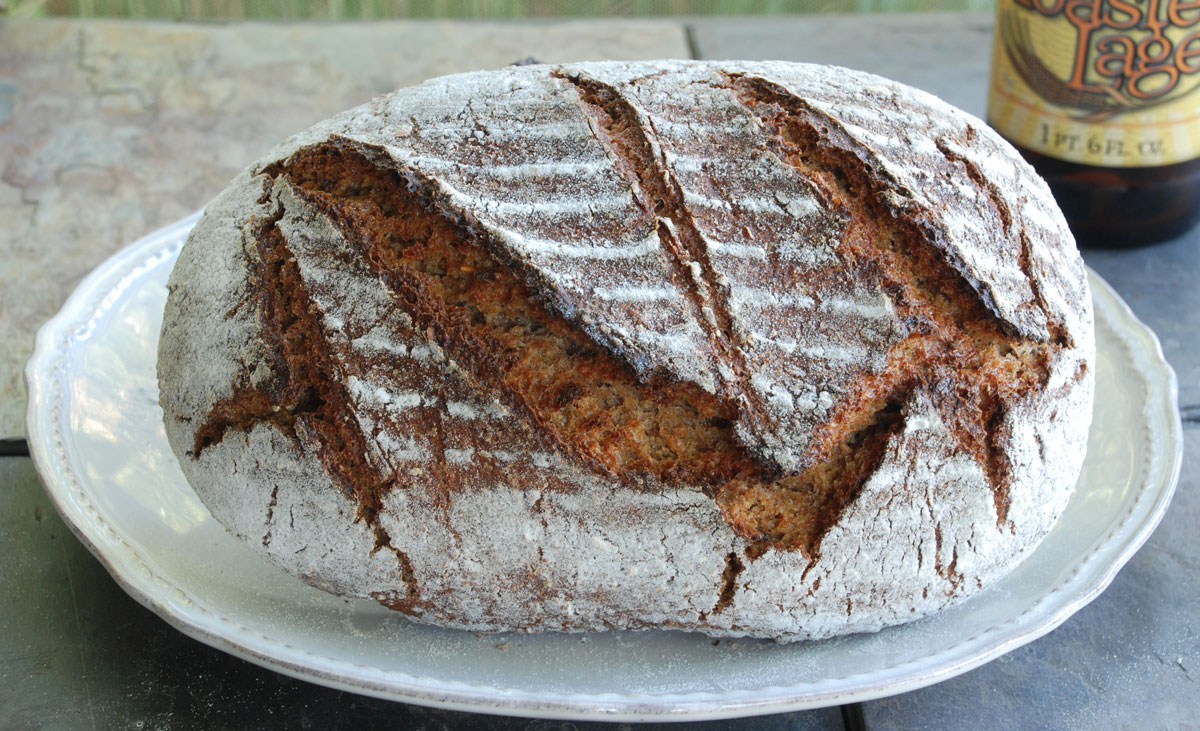 I decided to make a couple of breads to bring to my cousin's house for Rosh Hashana this weekend and she requested I make my Farro Hard Cider Multi-grain. I didn't have any hard cider available nor did I have time to make a Farro starter so I used a nice Long Island toasted lager and substituted my stock AP starter which I recently refreshed.
I decided to make a couple of breads to bring to my cousin's house for Rosh Hashana this weekend and she requested I make my Farro Hard Cider Multi-grain. I didn't have any hard cider available nor did I have time to make a Farro starter so I used a nice Long Island toasted lager and substituted my stock AP starter which I recently refreshed.
I also ground some soft white wheat berries I just purchased at the store from Bob's Red Mill. The package says this is similar to a pastry flour and it did seem to make a very soft flour.
For the soaker I added some rolled oats in addition to the cracked wheat I used last time.
I have to say the second version of this bread is definitely better than the first try.
This is a nice hearty bread great with some cheese or stew or for a nice pastrami or corned beef sandwich.
AP Starter
227 grams AP Flour
71 grams AP Seed Starter
151 grams Water at Room Temperature (80-90 degrees F.)
Mix ingredients in a bowl until thoroughly combined. Cover the bowl and let it sit at room temperature for around 8 hours. The starter should almost double when ready to proceed. You can either mix in final dough or put in refrigerator for at most 1 day before using. If your kitchen is warmer than mine which is usually about 70-72 degrees with my air-conditioning you can proceed sooner.
Soaker
60 grams Cracked Wheat
40 grams Rolled Oats
280 grams Boiling Water
Mix ingredients together in a bowl and cover. Let rest for 30 minutes or longer until ready to use.
Drain the liquid before mixing in the final dough.
Main Dough Ingredients
425 grams Refreshed AP Starter (65% hydration) from above
100 grams Soaker from above
190 grams Freshed Milled Farro Flour
80 grams Quinoa Flour
75 grams Wheat Germ
21 grams Potato Flour
65 grams AP Flour
55 grams First Clear Flour (KAF Brand)
120 grams Freshly Ground Soft Wheat Flour
60 grams Pumpernickel Flour (Dark Rye or Course Rye Flour)
50 grams Molasses
16 grams Sea Salt or Table Salt
445 grams Toasted Lager
Procedure
Mix the flours with the Lager and molasses in your mixer or by hand for 1 minute. Next cut the starter into small pieces and put in bowl and mix for 1 minute to incorporate all the ingredients. Let the dough autolyse for 20 minutes to an hour in your bowl and make sure to cover it. Next add in the salt, and the soaker and mix on speed #1 for 3 minutes or by hand and on speed #2 for 2 minutes. The dough should have come together in a ball and be tacky but not too sticky.
Next take the dough out of the bowl and place it on your work surface. Do a stretch and fold and rest the dough uncovered for 10 minutes. After the rest do another stretch and fold and cover the dough and let it rest for 10 minutes. Do one more stretch and fold and put the dough into a lightly oiled bowl and let it sit at room temperature covered for 2 hours. After 2 hours you can put the dough into the refrigerator for 24 hours or up to 2 days before baking. Feel free to do some additional S & F's if you feel it is necessary. I baked the bread about 24 hours later.
The next day (or when ready to bake) let the dough sit out at room temperature for 1.5 - 2 hours.
Next, form the dough into your desired shape and put them in floured bannetons, bowls or on a baking sheet and let them rise covered for 2 hours or until they pass the poke test. Score the loaves as desired and prepare your oven for baking with steam.
Set your oven for 500 degrees F. at least 30 minutes before ready to bake. When ready to bake place the loaves into your on your oven stone with steam and lower the temperature immediately to 450 degrees. The total baking time was around 45 minutes. When both loaves are golden brown and reached an internal temperature of 200 degrees F. you can remove them from the oven.
Let the loaves cool down for at least an 6 hours or so before eating as desired.
- Isand66's Blog
- Log in or register to post comments





We really like this bread inside and out. Multi-grain with lager and a soaker is our kind of bread. It has to taste wonderful. What I can't figure out is what makes this Farro Bread when there isn't any farro in it. We haven't been able to find any farro berries for some time after Whole Foods quit carrying them in the bins.
You will like the soft white wheat berries in French breads and pizza too.
Nice baking
OOPS! I forgot to type in the Farro flour!
Thanks for the compliment. I was very happy with the way this second attempt came out.
Think I had too many glasses of vino last night :).
By the way, the only Farro grain I was able to find at Whole Foods was in a package and was double what I paid at the supermarket. I bought it anyway but have to return it after I found it at my local Shoprite. They have a nice selection of packaged grains, rices and a good selection of Bob's Red Mill products. I did buy some white spelt and whole spelt grains from Whole Foods to try and grind them up along with another grain I can't recall.
You may be able to find Farro on-line at a reasonable price.
Regards,
Ian
Ian, I stumbled on this recipe looking for something to do with Farro. It is now one of my favorites. It makes the most amazing sandwich bread. I am wondering if you can advise, though this may be long forgotten by you. The only thing I can't find is the First Clear. KAF doesn't seem to have it anymore. I substitute hard winter red.
My question is, is this supposed to be very hydrated? "The dough should have come together in a ball and be tacky but not too sticky." Even cutting the lager down to 400 g, It does not ball up. In the end it is difficult to shape and comes out flat. But when baked in an Emile Henry Loaf Baker, it comes out great. I would like to have Batards if possible.
And yes, I am a beginner.
I sure would appreciate advice if you can remember or have thoughts.
This is certainly an old one but I do remember it was tasty. I’m surprised you can’t find the First Clear flour on KAF. You can also try Bobs Red Mill. Instead of using more WW you may want to try AP or bread flour. Definitely cut back on the water/beer. Your flour may not react the same way as what I was using and also the humidity can also effect how your flour will behave. I always hold back 50 to 75 grams of liquid and and it back in as needed after a 30 to 60 minute autolyse. There could be other reasons your dough is too slack. You may need to do more stretch and folds or a longer mix. I hope this helps but feel free to ask more questions as I’ll be happy to help if I can.